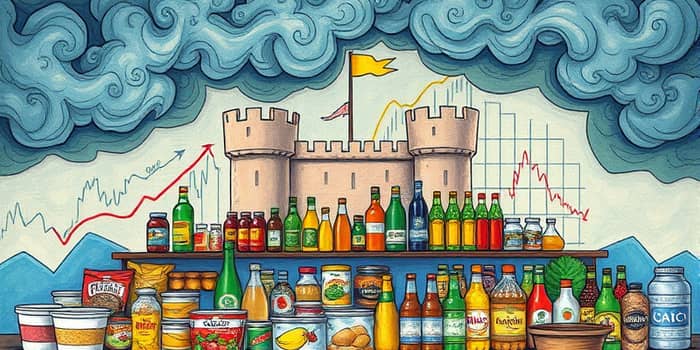
Consumer staples have cemented their role as defensive bulwarks when markets turn volatile. This in-depth analysis illuminates the factors that drive their long-term resilience and explores how investors can leverage this stability.
The consumer staples sector encompasses companies dedicated to producing essential items like food, beverages, hygiene products, and household goods. These companies benefit from steady demand regardless of cycles, as consumers continue purchasing necessities even during recessions. Unlike luxury goods or discretionary experiences, staples meet fundamental needs, creating a revenue base that is highly predictable.
Industry leaders often maintain extensive distribution networks and supply chain efficiencies, further bolstering their capacity to deliver consistent results. In many cases, they can negotiate favorable contracts with suppliers and retailers, allowing them to sustain margins despite cost fluctuations.
In financial markets, consumer staples earn a reputation as a defensive or risk-off sector. During periods of economic uncertainty—be it due to geopolitical tensions, rising interest rates, or deteriorating corporate earnings—investors seek assets that offer downside protection. Staples companies, with their resilient sales, become natural havens.
Data consistently shows that money flows into staples ETFs and index-linked products accelerate when volatility spikes. The sector’s lower beta profile translates into reduced drawdowns compared with cyclical sectors, making it a core holding for risk-averse portfolios.
Equity markets often oscillate between phases of risk aversion and risk appetite. In risk-on environments, investors pivot toward growth-oriented names such as technology and consumer discretionary, chasing higher returns. Conversely, when sentiment sours, allocations shift toward staples, healthcare, and utilities.
This dynamic underscores the importance of sector rotation strategies and tactical asset allocation for portfolio managers navigating shifting market regimes.
During the 2008 global financial crisis, the Consumer Staples Select SPDR Fund (XLP) experienced a modest decline of 11.4%, compared to losses exceeding 35% in the S&P 500. This performance gap highlighted staples’ capacity to cushion portfolio drawdowns.
More recently, in Q1 2025, the MSCI World Consumer Staples Index gained 5.5% while the MSCI World Index lost 18.2%. Prominent names such as Nestlé and Coca-Cola delivered double-digit gains, exemplifying the sector’s ability to thrive amid broad market stress.
Between 2022 and Q1 2025, consumer staples outpaced global equities consistently. In 2022, the sector outperformed the MSCI World Index by 12.7% in US dollar terms, as firms passed through higher input costs without materially eroding volumes. This pricing agility underpins staples’ reputation as inflation hedges.
Q1 2025 saw the following price performances:
These figures underscore staples’ relative strength when investors grow cautious about growth prospects.
Risk-off rotations are often triggered by rising interest rates, weak employment data, or central bank hawkishness. When bond yields climb, equities face headwinds, prompting a shift into lower-volatility sectors. Consumer staples benefit from this dynamic due to their robust dividend yields, which can exceed those of long-duration bonds in certain environments.
Furthermore, staples companies with pricing power to pass through inflation maintain healthy margins even when commodity prices rise. This capacity to adjust pricing helps firms preserve earnings per share and sustain investor confidence.
Several core characteristics drive staples’ outperformance during downturns:
Together, these factors form a framework that helps explain why staples remain attractive in risk-off scenarios.
Despite their defensive qualities, consumer staples face certain risks. In robust bull markets, high-growth sectors typically deliver greater returns, causing staples to lag. Additionally, a strong US dollar can pressure multinational revenues when converted back into dollars.
Changing consumer trends—such as a shift toward health foods, plant-based diets, or the impact of GLP-1 drugs on eating habits—pose strategic challenges. Staples companies must innovate and adapt to evolving preferences to sustain market share.
For long-term investors, incorporating staples can enhance a portfolio’s risk-return profile. A typical allocation might involve overweighting staples to 10–20% of equity exposure, depending on risk tolerance and market outlook. This balanced risk-adjusted approach helps smooth volatility across economic cycles.
Portfolio managers often combine staples with utilities and healthcare to create a triad of low-beta sectors. This strategy can reduce overall portfolio variance while still offering growth potential through dividends.
Consumer staples exhibit resilience in both developed and emerging markets, but regional nuances matter. In emerging economies, rising disposable incomes and urbanization drive demand for packaged foods and beverages. However, local regulations, tariffs, and supply chain disruptions can introduce volatility.
In developed markets, staples firms remain vigilant about regulatory changes related to labeling, health standards, and environmental policies, all of which can affect operating costs and brand reputations.
Several industry leaders illustrate staples’ defensive power: Nestlé leveraged its diversified portfolio to achieve 19.3% gains in Q1 2025, while Coca-Cola’s global distribution network fueled a 15.0% rise. Mondelez and Danone also delivered mid-teens returns, further proving the sector’s potency during market downturns.
These success stories highlight the importance of brand strength and robust distribution channels in maintaining sales momentum, even when consumer spending overall is under pressure.
Consumer staples have proven time and again that they excel as defensive assets in risk-off environments. Their unique combination of predictable demand, pricing power, and stable cash flows offers investors a reliable buffer when markets become turbulent.
By strategically integrating staples into diversified portfolios, investors can not only protect against downside risk but also secure consistent dividend income. Ultimately, these timeless businesses remain essential components of any robust investment strategy.
References













